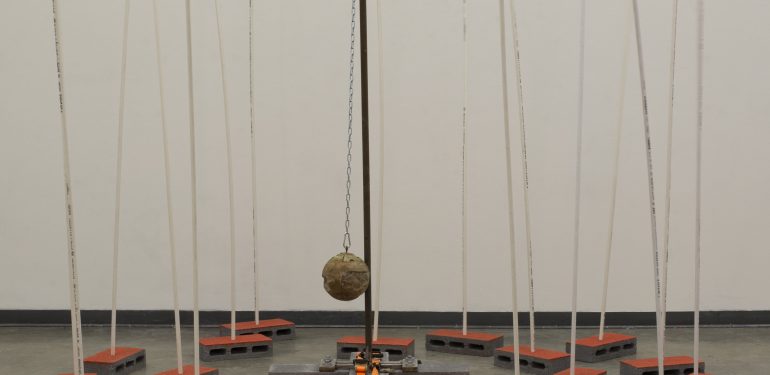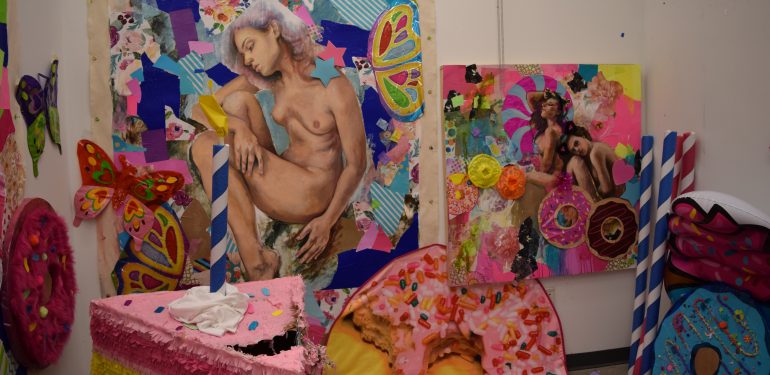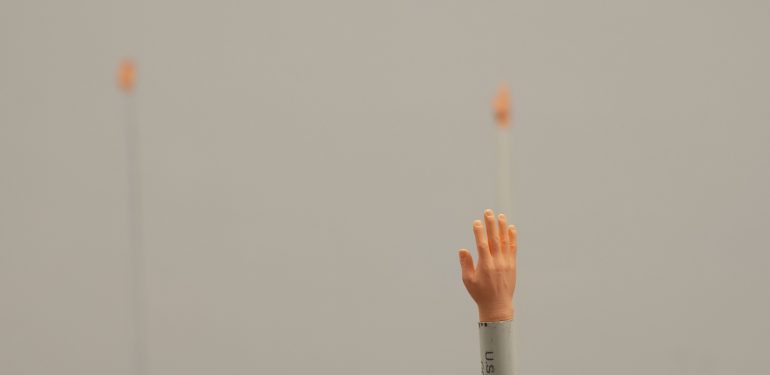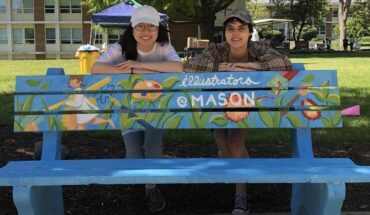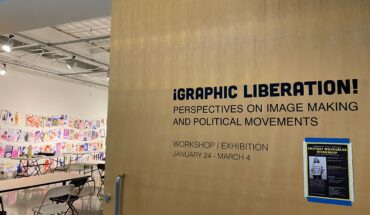Mason Art Students and the Meaning Behind Their Work
BY KATHYA MENDEZ, STAFF WRITER
While you could immediately think of paint and pencils when thinking of art, art students at Mason actually work in a variety of mediums such as portraits, drawing, sculpture, ceramic, printmaking and more. This variety is reflected through the diverse types of projects displayed in the hallways of the Art and Design Building and throughout gallery exhibits on campus. But, behind the projects that we all see, what is it like to be an art student?
Andrea Sanchez-Mendoza is a junior double-majoring in communication and integrative studies with a minor in multimedia. Since she started studying at Mason, she decided to take classes to continue expanding her knowledge in art design. Art has been a part of Sanchez-Mendoza’s life since her early teen years.
“I was always into designing,” said Sanchez-Mendoza. “I liked interior design, fashion design. … [In] my junior and senior years [of high school], I filled up my schedule with art classes, so that was the foundation that helped me build up my skills.”
Harry Mayer is a senior pursuing a bachelor’s in fine art (BFA) with a concentration in sculpture. Mayer got into art when he was younger by observing his dad’s work, since his dad is a contractor and a carpenter.
“I kind of learned how to build things, and [I] try to incorporate that into my practice,” Mayer said. “My dad is a carpenter, but I kind of [went] my own way.”
When it comes to art projects, artists generally have specialties they tend to focus on as they continue improving their skills through practice. To create innovative artwork, creativity as well as exploring new techniques and strategies are crucial.
Jennifer Lillis is a graduate student on her third year of Mason’s master’s in fine art (MFA) program. One of her focuses as a sculptor is found objects, which are unusual materials upcycled to be used artistically.
“You take a brick back to the studio and try to change its function: you put it [on] a pedestal, and so you’re elevating its status, thinking of the shape and the form, texture and more,” Lillis said. “[It] is taking something and repurposing [it] into something else.”
Andi Benge, a first-year graduate student, described how she produced her art.
“I have a weird process of listening to songs, and their lyrics kind of trigger a weird setting in my head that I envision this strange world. It always starts with the female nude figures and then I kind of build from there,” Benge said.
For Sanchez-Mendoza, whose specialty is photography, the juxtaposition of soft and harsh lines is special. “[It] is just pretty and very elegant, [and] it’s timeless too,” she said. “That is why I would prefer nature and architecture over people.”
Mayer, on the other hand, is a sculptor whose exhibit will be taking place on Dec. 15 at Greater Reston Arts Center in Reston, Virginia.
“I made like a series of playground equipment,” he said. “I proposed a series of interactive and playful sculptures, and the main point is basically to make somebody smile.”
His sculptures include a seesaw and small hands on the top of PVC tubes along with cinder blocks, steel and plywood.
Lillis expresses herself “very abstractly” through her art. “I express myself through the deconstruction of not just the theories and the concepts, but the actual physical material,” she said.
While studying and making art is fulfilling to those passionate about it, there can be some disadvantages to pursuing an art education. Some of these include the unfavorable odds of making money so they can pursue art for a living, other people taking advantage of the artist’s skills and the need for connections to get a start in the field.
Although artists can face these problems, they do not necessarily stop them from pursuing their passion.
In Benge’s case, she said, “I took a break in between undergrad and graduate. I worked, but when I was at home I felt so frustrated because I just wanted to make stuff, and you just don’t have time, and [it] is like you just have to let it out.” Benge’s passion for art led her to start her MFA program at Mason.
Mason provides many associations for students to get involved outside the classroom environment. One of them, AIGA-Mason, is a “student organization [that] is committed to … understanding … the value and process of design to aspiring professional graphic designers,” according to the School of Art’s website.
Another student organization is Focus Group. Their major goal is “to educate and stimulate conversation regarding all types of professional photography.”
Student artists continue to incorporate different methods of engagement with their work. Their art is a form of self-expression and part of their identity as individuals.

